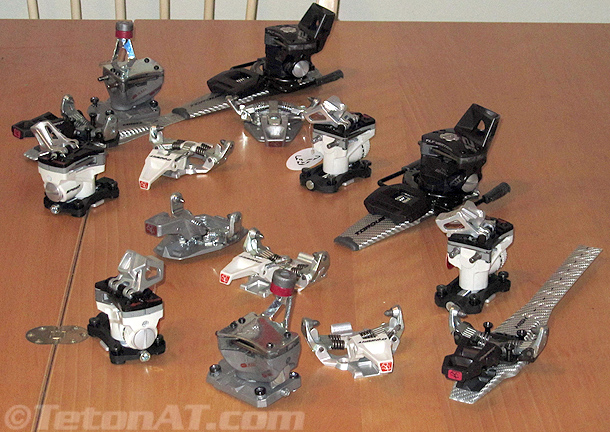
Too many Dynafit options is a good thing.
Like you, I often struggle to decide what bindings I want to mount on which skis and it kills me when there are so many great options out there. On some skis, lightweight is the most important factor, but for other skis, having a bit more boot retention and downhill security sometimes trumps going with the lightest option out there. Add in the fact of changes in binding design and construction over the years, and a person can really drive themselves crazy looking for the perfect AT binding setup.
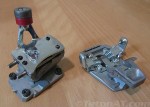 I’m partial to Dynafit and in general, my favorite binding over the years has been the Speed Classic. The old-school design that has proven itself, is simple, light and quite durable. Yes, the relatively newer Vertical
I’m partial to Dynafit and in general, my favorite binding over the years has been the Speed Classic. The old-school design that has proven itself, is simple, light and quite durable. Yes, the relatively newer Vertical 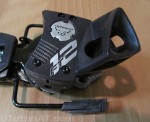 series does have its advantages, like an increased heel pin length, a larger range of adjustment for different boot sole lengths and ease of use regarding moving to different climbing bar heights using your ski pole (as well as DIN to 12 with the Vertical FT model), but some of these features can often be sacrificed in the quest for lighter weight.
series does have its advantages, like an increased heel pin length, a larger range of adjustment for different boot sole lengths and ease of use regarding moving to different climbing bar heights using your ski pole (as well as DIN to 12 with the Vertical FT model), but some of these features can often be sacrificed in the quest for lighter weight.
In addition to the challenges in deciding between the bindings mentioned above, the newest and latest/greatest Dynafit Radical series of bindings also have their own advantages. A stronger and more rigid toe piece with the addition of Power Towers, wider mounting pattern and single piece machined aluminum construction, really ups the bar from the older bent steel plate base-plate and plastic lifter that was used in nearly all the Speed and Vertical binding generations.
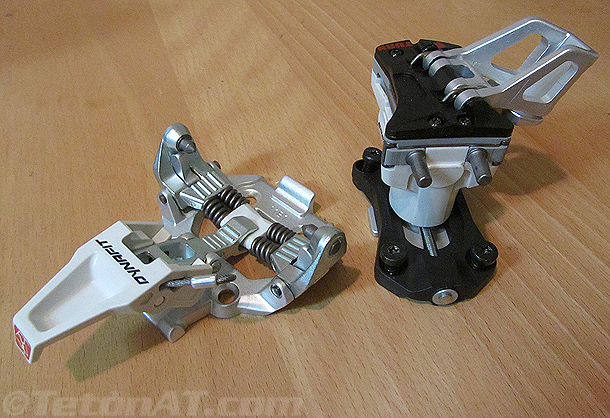
The Speed Radical seems to be the most popular of Dynafit’s new Radical series of AT bindings.
Though there are advantages in the design of the counter-clockwise-only rotation (eliminates auto-rotate while in tour mode) and the flip-able climbing bars (easier, faster, more durable?) in the new Radical bindings, I’d have to say from my own perspective, and the vibe I’ve been getting from some other folks, the jury is still out on how these changes in heel-piece design will be received by the public. Old habits are hard to break and having to bend over (instead of just using my pole) to engage into ski mode has honestly kept me up at night over the last few weeks as winter gets closer. (I know…First World problem.)
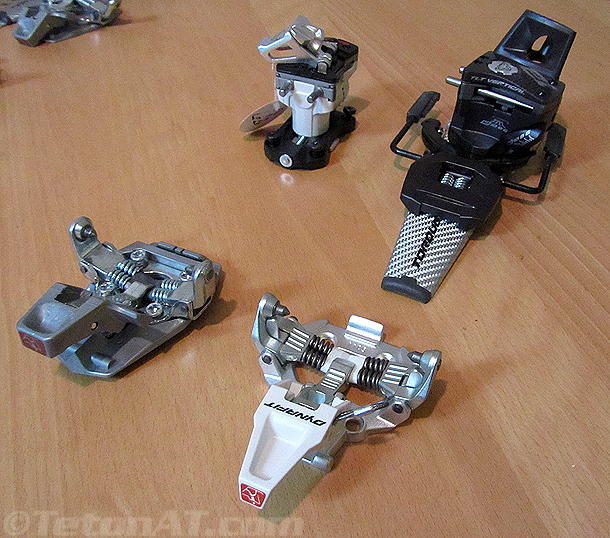
Would a hybrid Speed Radi-Vert FT (right) be the best of both worlds?
With all that being said, I am definitely going to mount at least one setup this year with a complete Speed Radical binding and I’m keeping my mind open to the new Radical heel-piece design. But, I also think I’m going to try out a hybrid Speed Radical/Vertical FT combo or “Speed Radi-Vert FTâ€, which will consist of a Speed Radical toe-piece and a Vertical FT heel-piece. The skis I’m thinking about for this binding setup are quite wide, but also lightweight, and I don’t want to anchor weight them with a full Radical FT setup. At the same time though, I also want a little more DIN boost in the heel than just a straight Speed Radical heel-piece. With a Speed Radi-Vert FT hybrid binding, I get the best of both worlds since it offers a bomber, rigid, and lightweight toe-piece of the Radical, along with the increased DIN to12 and ease of use in heel-piece position selection of the Vertical series of binding in the back.
On the flip side of this, it also seems like a combo of a Speed Classic toe-piece and a Speed Radical heel-piece, or “Classic Radicalâ€, might be something fun to play around with on a narrower pair of skis. Anyway, something to think about if you’ve got a couple generations of Dynafit bindings lying around.

I honestly had this exact conversation with the hardgoods buyer from AMH just last week. Must be nice to have an unlimited supply of raw materials!
I was thinking a Plum Guide heel piece with a Dyna Radi toe mounted with a 4mm shim under it to lower my ramp angle. Mmmmm, customization.
I’m with you Drew, The hybrid could be interesting, but then why not just go with the plum guide toe as well? The thing (likely the only thing) I like about the radical speed toe is that there is no plastic under the toe unit of the binding…
Radical ST vs. Vertical ST compare contrast:
http://unofficialnetworks.com/ultimate-dynafit-gear-review-radical-series-alpenglow-sports-50011/
funny colin…i guess all shop rats think alike. (and have way too much gear at their disposal. 🙂 )
brendan…some good info here as well.
http://www.tetongravity.com/forums/showthread.php/230338-Dynafit-Radicals-vs-Verticals
mike…what is it you don’t like about the dynafit radical toe piece?
i mean, the plum toe is virtually identical (remember, it’s using all of dynafit’s expired patents), if not less robust due to the lack of power towers and smaller mounting pattern. so take your chances i guess, but to me they seem to have unproven durability and track record. have they been available in europe very long?
Yo Steve, although it seems we are sworn enemies now, I thought this was an interesting post…
My vote would be a radi-speed toe, frankenfitted with springs from a plum toe for the 12 DIN (are they actually stiffer? they sure seem like it) with Plum heel. I like the looks of the speed SL heel, but it looks like it might have a real weak point where the tripod base meets up with the rest of the heel unit, which doesn’t seem at all necessary seeing that it doesn’t need to rotate right there… Why not just make it a solid piece of metal, top to bottom, put some 14 DIN springs in it, and squash the competition? (and make an SL toe to match)
I just shot my wad on a pair of Plums, and am pleased, but the weak point seems pretty obvious, at the intersection of the toe pin with the toe arm, as someone on TGR found out. It looks like Plum just copied the old style dynafit toe, and forgot that they were using aluminum instead of steel on the arms. Here’s to hoping it doesn’t break. All the axle pins in the toe seem a bit small as well.
It seems like dynafit is letting their marketing dept do too much product design with the 12’s, and their theory seems to be that if they throw enough plastic on it, it will look beefier, people will think it’s beefier, and they will buy it. My hope is that they reverse this trend and take a hint from Plum and go to a simple, strong, metal design with a high DIN for their 12 (to 14?) series.
peace out josh.
do the toe springs of the plum actually hold you in more or just kinda clamp down tighter? all the DIN is still calibrated at the heel…right?
the speed super light is stripped down and built for light weight. the tri-pod design was probably the lightest way to get the right height. the mounting points are so close together that i wouldn’t mount them on anything over…i don’t know…maybe 80mm? slick toe-piece though…kinda plum like?
http://www.dynafit.com/product/bindings/tlt-speed-superlite
i think there is some benefit to the designs of the radical ft, mainly in toe-piece rigidly, and strength and performance on fatter skis. i think the ABS shock thing probably does a little bit of dampening and stiffening of the ski…if you want it…and maybe depends a lot on the ski (stiff or noodle soft?) you mount it on. and like i said before, i think the jury is still out on the new heel post design.
maybe the downside of making a solid heel post/mounting plate, with no adjustment for boot size, is that there would be more f-ups in the shop when mounting? it seems to me like you’d want at least some adjustment in BSL length (at least in a mass produced product) for when you buy new boots, use two pairs of boots, or just miss the mount by a mm or two, which can really mess with the functionality of the binding. maybe i’m wrong with this assumption. remember, not every skier out there is tech savvy, so the big dogs need to make their products useable by a wide demographic of people.
who knows…maybe someone else will jump into the tech-binding mix soon. seems like a logical next step for a few big companies out there or some small start up…no?
I just ordered the Speed Radicals for a new pair of skis. I’ve been using Vertical ST’s in the past and I love the heel piece design. I’m skeptical of the new heel design on the Speed Radical, but I’m interested in giving them a shot. If I decide to switch out my heel pieces for the old ST’s, will the holes match up or will I need to drill again?
Thanks for any help
ben…the holes should match up for the heels if you decide to switch. pray for snow.
In your hybrid idea: are you going to use the FT brakes (doubt it) or yank them off? I’m disappointed how difficult Dyna has made to to remove the brakes from the FT as compared to older TLTs.
ted…no go on the brakes.
bring your skis by the shop if you are having trouble with the brakes. should be able to get them off in about 5 minutes.
Steve – wouldn’t a Speed Radical toe and Vert FT heel piece give you serious ramp angle? I’m considering going with the Speed Radicals and then seeing if Salewa (sp?) will offer the Radical ST Power Plate aftermarket for a bit more toe height (and stiffness?) thus zero ramp. Not a fan of how much my Vert FTs throw me in the front seat. Can’t imagine them with an even lower toe.
brain..yes, after further examination, there would be lots of ramp angle with this combo. i think i need to get a radical st base plate to make this work.
Steve,
Have you ever mounted a pair of vertical FTs without using the fiberglass connector plate. It is my understanding that it doesn’t have any real purpose, so I’m curious what your thoughts are on this. Wouldn’t it be the equivalent of a 12din vertical ST?
Also, when you mount the vertical FT or ST on skis over 100mm in the waist, are you using the “power plate”. It’s my understanding that this is recommended, but I don’t see too many of them out there.
Thanks for the advice.
From the pictures it looks like the Speed Radical toe will not fit on the ST base plate without grinding down the plastic bump that sticks up under the toe lockout lever.
cameron…i have only mounted vertical fts after cutting the thin section of connector plate between the heel and toe piece…never w/o the entire plate. it seems as though you could remove the entire silver plate…and even cut off some of the plastic in front of the heel-piece if you really wanted to.
i haven’t used the power-plate and have mounted vert fts on megawatts (125mm waist) w/o any issues, problems or breakages. BUT, i only ski that setup in powder and not on hardpack. my tlt speed classics seem fine on justices as well…without any power-plate.
mike…i don’t think that is correct. the bump is part of the aluminum baseplate on the speed radical and also part of the radical st.
I am talking about the black plastic bump that comes up between the two aluminum bits that engage the toe lock. The Speed has a flat piece of aluminum between the two aluminum bumps that lock the toe while the ST has part of the plastic base plate rising above the aluminum toe.
Mike…there is a slot under that plastic piece of the ST base-plate for the aluminum plate to slide under.
Anyone know where to purchase dynafit toepieces? I have an old set of uber crappy tri-steps I’d like to remount.
gerard…i’ve heard of splitboarders buying toe-pieces directly from Dynafit/Salewa NA. they can probably help you out…especially if you mention your replacing some tri-step toe-pieces.
http://www.dynafit.com/contact.html
I think they will sell any part individually. I’m thinking of getting Superlight Radical toepieces matched with Speed Radical heels. Does anyone think this sounds like a good idea, or bad? How much weight savings will I get?
So what you’re saying is you have cut the fiberglass connecting point just behind the toe piece, and then just in front of the heel piece, with no adverse effect. Or am i missing something, and if so, then why not just remove the whole thing. thanks for the info, it just seems like a gimmick to me, although it does seem to have some aesthetic value if nothing else. thanks. Cameron
yeah cam…just the thin piece between the toe and heel-piece. you could probably remove the whole thing, but you might run into some problems regarding spacing with the toe lever and screw length…since that 1-2mmm of glass isn’t there anymore.
Cameron
I’m not sure it applies to the vertical FT binding but I know some people have mounted even older speed bindings directly on the ski and had trouble because the toe lock lever no longer had anything to hold it in place. I also wonder if you need some clearance under the bottom part of the toe wings so they can go through their whole range of motion. I would try mounting them on a 2×4 and playing with them on there to see if these things are issues before you mount them that way on a ski.
Steve
Do the speed radicals heel units have a different height to them compared to the st and ft or are they the same?
David…it appears as though the Radicals have a lower highest setting. I’m not sure about the middle height. I’m waiting for some skis to mount my Radicals on to do a proper comparison.
There is hope for some after-market parts that may offer higher heights and/or usage or your ski pole to rotate the heel…fyi.
Sorry I didn’t phrase my question clearly. I’m wondering about the ski mode height and ramp angle.
dave…well, i think that depends on which bindings you are comparing.
comparing the speed radical to the speed classic….
-the speed radical is a couple millimeters higher off the ski.
-ski ramp angles look similar.
sorry…but that is the best i can give you right now. i will try to find out more and report back.
david…sounds like there is no difference in ramp angle between comparable dynafit bindings. and like i said above, the radicals sit just a tad higher off the ski than the vertical st and speed classics. the one difference is that i think the radical ft sits quite a bit higher than a vertical ft…since it’s got way more shimmage and platage underneath.
I’m looking to mount some Dynafits on a set of Voile Chargers this winter. Haven’t purchased any backcountry ski equipment in over 10 years and haven’t ever purchased or used Dynafit bindings. Currently torn between the Speed Radical and the Radical FT. I will be using this setup in all types of conditions ranging from powder to cement to spring corn.
The 18 oz. weight savings on the Speed Radical is very appealing since I will be earning more or less all of my turns this year, but will I miss the extra performance features of the FT on the downhill – especially given that I’m a fairly heavy (200 lbs) and aggressive skiier, and that the Voile Charger is a pretty stiff ski?
Any input is appreciated – mainly looking for info. on what exactly the FT offers over the Speed.
greg…man, those are two opposite ends of the spectrum.
i think seeing how it is your first dynafit setup and you are a big guy, i would probably lean more towards the burly side, rather than light side…until you know how the bindings perform for you and since you will be using these skis for all conditions. as well as the ability to use brakes (it’s easy to loose a ski if you aren’t careful when not using brakes), so i guess Radical FT is my vote.
it would be interesting to see how much weight you could save by trimming down the Radical FT by removing as much of the ABS base plate as possible. it just seems like something i wouldn’t really mess with, but the supports under the toe-piece are nice feature with the Radical FT for bigger skis.
You can find some info on ramp angle at
http://www.wildsnow.com/4828/dynafit-radical-backcountry-skiing/
Hi – thanks for the reviews and good comments!! I am new to the backcountry and am making the switch to dynafit as soon as possible!! I have 3 possible bindings that i can get my hands on – the speed radical, the vertical st and the vertical ft. I will be mounting these on a 181 K2 Hardside (not the lightest ski and has a little metal). As for me, I weigh 170 and am about 6’1″. I ride pretty aggressively and like steeps. I do not plan to get any major air and def not if the snow is not soft. I usually stay within 10 feet of the ground.
So what binding do you all think i should get and why?
It is a really hard decision for me and I want to get it right!!!